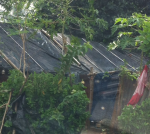Subhas Chandra Pattanayak
If Ms. Margareta Wahlstrom, Special Representative of the Secretary General (SRSG) for Disaster Risk Reduction has truly said, “Orissa’s handling of the very severe cyclone will be a landmark success story in disaster management”, then perhaps her premature observation was shaped by her telephonic conversation with Chief Minister Mr. Naveen Patnaik on October 15; because she has not seen or studied the reality to form this opinion.
Phailin itself was not the disaster. Its effect is. So, management of the after effect of Phailin is disaster management and that management is yet to be studied. Any praise for the government would be held unqualified, premature and misled by hearsay.
The schedule of the cyclone known very much ahead of landfall, the government should have published a white paper on its preparedness for or action taken on the storm immediately before or after the cyclone, so that authentic information on the role of administration could have come to notice. In absence of such a white paper, it is totally premature to conclude that the state’s action “will be a landmark success in disaster management”.
Reports galore that post-cyclone relief operations are most disorganized, inadequate and anarchic. Due to improper maintenance of embankments, flood induced by cyclone has severely damaged standing crops in about 6.5 lakh hectares and around 1.2 crore people in 148 blocks, 16,487 villages, 43 urban areas are seriously affected. People are devastated by Phailin and flood as medical care is inadequate, safe water is not available, food is beyond reach, power is not restored. What to speak of other places, in the capital city of Bhubaneswar, street light is not restored as yet.


 The pictures, taken at 10 pm last night, gives us the evidence of how Bhubaneswar roads are drowned under darkness five days after the storm. Is it efficient management of the disaster?
The pictures, taken at 10 pm last night, gives us the evidence of how Bhubaneswar roads are drowned under darkness five days after the storm. Is it efficient management of the disaster?


 Except the very tall ones, trees, like in most places under the storm’s furry, are safe in Bhubaneswar, though a few of the small branches and leafs are ripped off. Pictures taken on October 16 show how they are lying heaped on the roads/footpaths and even in the inner campus of the Capital Hospital to the detriment of human health.
Except the very tall ones, trees, like in most places under the storm’s furry, are safe in Bhubaneswar, though a few of the small branches and leafs are ripped off. Pictures taken on October 16 show how they are lying heaped on the roads/footpaths and even in the inner campus of the Capital Hospital to the detriment of human health.
Just after the cyclone, before closing for Puja Holidays, in his signed column ‘Ama Gharara Halchal’, Sambad editor Soumyaranjan Patnaik had praised the state administration for having successfully faced the cyclone. But the very same newspaper on October 16 has captioned its first story as “Sudhuru nahin – pani, bijuli, khadya kichhi milu nahin” (No improvement; water, electricity, food – nothing available)! The Samaja, the paper of Gopabandhu, kept in capture by a combine of thugs with the help of the chief minister, despite being pledged to act Naveen’s propaganda blitzkrieg, has not dared to entirely suppress different discernible instances of mismanagement of the disaster. It has headlined a report that shows how huge quantity of rice has vanished from the stock of relief materials. “Sheshare relief samagri bi baad padilani’ (Lastly, relief materials are not spared), the Samaja has reported under the caption that reads “191 quintals of rice vanished!” Another of its captions shows how the citizens of the capital city are yet in darkness. Open any newspaper, comes to eyes the footprints of mismanagement of relief operation and black-market.
The tall claim of evacuation of about 10 lakh people to safe shelters has no basis. It is nothing but propaganda aimed at vote catching by the ruling party.
The government has been bragging about having posted all information on how ably it has managed the present disaster in the website of Odisha State Disaster Management Authority.
The above picture is the latest screen shot of the News / News & Media / Press Release page of the said authority’s official portal. “No news available for this month (October) & year (2013) it asserts in red color!
The controlling authority being the Special Relief Commissioner, I went to where the SRC places details of his activities in the net, in hope of having the necessary data on management of the current disaster. It was entirely disappointing. How the special relief organization functions? The picture posted below is the latest screen shot of the relevant portions of the site.
It stoutly shows that the post of Additional Relief Commissioner is vacant and “job allotted” to the Special Relief Commissioner is “Head of Department”! And the most offending admission of administration is spelt out sans any qualms in the footnote that says, “Information available in this manual was last updated on 3rd January, 2012”.
This is how disaster is managed. The SRSG Ms. Margareta Wahlstrom should feel ashamed of her unqualified observation cited supra which is being used by the misruling Chief Minister through obliging media for political purpose when the election environment has already evolved.
Curiously, the low casualty marked this time is being compared with the high casualty the 1999 super cyclone had caused, which appears to be a trick to make people believe that this magic was possible, because of Naveen’s stress on “Zero Casualty”.
This is blatantly wrong.
The Phailin had threatened to be a category 5 super cyclone while gathering strength from a combination of warm water and low wind shear over the Bay of Bengal (Mahodadhi); but on landfall, in most of areas under its sway in Orissa, it was at best a storm of category 1 or 2. But despite this, had Phailin been as katabatic as was the 1999 super cyclone, the State being in a total administrative anarchy with a deadly reduced manpower, the casualties instead of being 21, could certainly have exceeded all past records.
First hand pictures placed here show how lowest-roofed huts and hovels were not touched by Phailin. Casualties were meager because of this reason.
The storm gushed out much above the ground. Only the tallest trees were uprooted when plants of low hight survived.
When tall coconut trees struggled hard to withstand the storm, smaller plants on the ground could not know how hard was the hit. Naturally, in such a situation, human beings were physically safe. Claim of credit by Mr. Patnaik and his team for abysmally low figure of human casualties is based, not on facts, but on political motive addressed to net in votes when election comes.
The government has utterly failed in risk reduction as the post-cyclone inundation in the districts, not so much affected by Phailin, establishes. Innumerable diabetic patients could not preserve essential insulin in their refrigerators due to power failure. This is just an instance. But power failure and flood cannot be completely attributed to the storm’s fury as these phenomenon are outcomes of continuous negligence to review and refinement of power utilities and maintenance of embankments.
So, this deserves to be kept on records that we were spared of greater casualties, not because Mr. Naveen Patnaik gave a good governance, but because, Phailin was anabatic beyond the Gopalpur port with lesser flounce.
The Special Representative of the UN Secretary General (SRSG) for Disaster Risk Reduction Ms. Margareta Wahlstrom is clearly in fault for having said, if really she said, what she is reported to have said.








1 comment » Write a comment